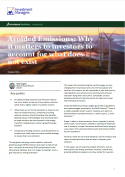
Avoided Emissions: Why it matters to investors to account for what does not exist
- 10 October 2024 (7 min read)
KEY POINTS
To stop global warming, society needs to reduce its greenhouse gas (GHG) emissions and reach a state of net zero – the point at which the GHG concentration in the atmosphere stabilises and is no longer increasing1 . Such a goal requires an energy transition.
This means fully transforming the world’s energy mix and changing how we produce and consume food, goods and services. As investors, we ask companies to play their part by reducing their own emissions and contribute to emission reduction along their value chain. Companies can also develop products and services which can help users lower their individual emissions.
Corporate GHG accounting is largely governed by guidelines and methodologies produced by the GHG Protocol2 . There is a widely accepted system used to measure and report on direct/indirect corporate emissions - called scope 1, 2 and 3 emissions3 .
Scope 1 refers to direct emissions from a company’s activity while scope 2 are emissions related to operational electricity use. A company’s scope 3 emissions are those found along its value chain, both upstream (before) and downstream (after) its own operations.
However, there are no formal standards used to measure and report avoided emissions that are due to company-sold solutions.
In this paper, we will examine avoided emissions, look at their place in the energy transition narrative, outline their potential pitfalls and explain why they matter for investors.

- [1] Climate change: The relationship between net zero and rising global temperatures
- [2] Standards & Guidance
- [3] Understanding scope 3: How responsible investors can wrestle with the unruliest of emissions
Disclaimer
The information on this website is intended for investors domiciled in Switzerland.
AXA Investment Managers Switzerland Ltd (AXA IM) is not liable for unauthorised use of the website.
This website is for advertising and informational purpose only. The published information and expression of opinions are provided for personal use only. The information, data, figures, opinions, statements, analyses, forecasts, simulations, concepts and other data provided by AXA IM in this document are based on our knowledge and experience at the time of preparation and are subject to change without notice.
AXA IM excludes any warranty (explicit or implicit) for the accuracy, completeness and up-to-dateness of the published information and expressions of opinion. In particular, AXA IM is not obliged to remove information that is no longer up to date or to expressly mark it a such. To the extent that the data contained in this document originates from third parties, AXA IM is not responsible for the accuracy, completeness, up-to-dateness and appropriateness of such data, even if only such data is used that is deemed to be reliable.
The information on the website of AXA IM does not constitute a decision aid for economic, legal, tax or other advisory questions, nor may investment or other decisions be made solely on the basis of this information. Before any investment decision is made, detailed advice should be obtained that is geared to the client's situation.
Past performance or returns are neither a guarantee nor an indicator of the future performance or investment returns. The value and return on an investment is not guaranteed. It can rise and fall and investors may even incur a total loss.
AXA Investment Managers Switzerland Ltd.






